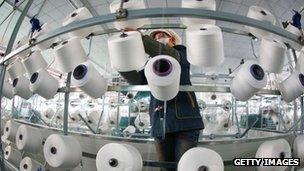China growth shows signs of pick-up from 13-year low
- Published
The BBC's Damian Grammaticas reports from the huge port of Wuhan, which is representative of China's changing economy
China's economy, the world's second largest, is showing signs of a rebound that could help it emerge from its worst economic period in 13 years.
According to the latest government figures, growth picked up to 7.9% in the final three months of 2012, from 7.4% in the previous quarter.
This was driven by state investment in infrastructure projects and efforts to get consumers and companies to spend.
Economic stability is seen as vital for China as its new leaders take over.
"It is obvious that the slowdown in the Chinese economy has halted for the moment," said Fraser Howie, an economist and co-author of Red Capitalism.
"But one has to be mindful that any recovery will be limited in its scope, not least because of the various headwinds that China is facing," he added.
"The new leaders, who take charge in March, will now have to find the right balance between trying to prevent the formation of a property bubble and keeping a healthy growth rate going."
That may prove tricky, not least because China's economic growth has slowed significantly from the highs of previous years, and analysts warn that state stimulus measures may wane.
On Friday, the statistical office reported that gross domestic product, the main measure of growth, increased by 7.8% in 2012, down from 9.3% in 2011.
That was the slowest annual rate of growth since 1999.
But it is still way above the anaemic growth rates experienced by most other major economies last year. Figures for the US, the world's largest economy, and Japan, the third largest, are expected to show growth of about 2%.
The 17 members of the eurozone are collectively expected to contract by about 0.4%.
'Transition economy'
Rajiv Biswas, from IHS Global insight, told the BBC that the days of China's blisteringly fast growth look to be over as the country moves from a low-income country to a middle-income one.
"For 30 years, China grew at about 10% on average, but the Chinese economy is now in transition," he explained.
"They have an ageing population and declining marginal productivity of capital. These are longer-term trends that mean they cannot grow at 10% forever."
Mr Biswas expects growth to average between 7% and 8% over the next few years, which is in line with government expectations.
Along with the longer-term reasons for the slowdown, there are some other factors affecting China in the short term.
Slower growth in the US and Europe have seen demand soften for Chinese products. At the same time, China has struggled to stoke its domestic demand.
The government also took measures to cool the property market amid fears that a bubble was developing, something that also impacted the speed at which the economy expanded.
Recovery signs

Manufacturing is a key driver of China's growth
These factors brought down the pace of growth late last year to uncomfortable levels, with some economists predicting a "hard landing", or a sharp slowdown.
However, their pessimistic predictions of a slump to growth of 6% seem to have been too extreme.
Instead the government implemented infrastructure spending programmes to spur growth and also provided incentives to encourage consumer spending and corporate borrowing.
"The government's stimulus measures implemented last year have managed to stabilise growth and lay the foundations for solid expansion this year," said Dariusz Kowalczyk of Credit Agricole CIB.
The figures released on Friday were "the best we could have wished for", he added.
Market bounce
Underlining this optimism were other figures also released on Friday which showed an improvement in house prices and retail sales.
Asian stock markets ticked higher on the news, while the Australian dollar gained. Australia is a key exporter to China, selling minerals that are used to help power its economic expansion.
Hong Kong's Hang Seng stock index was trading 0.7% higher, South Korea's Kospi added 0.5% and Australia's main stock index gained 0.3%.
Japan's Nikkei 225 was the biggest gainer, adding 2.1% and getting an extra lift as a drop in the value of the yen helped exporters.
- Published18 January 2013
- Published10 January 2013
- Published2 January 2013